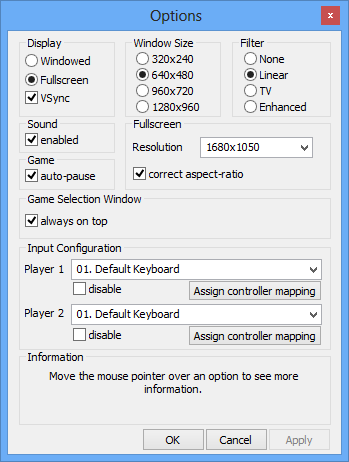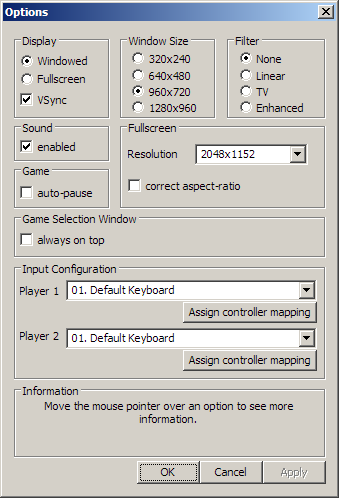Sega Genesis Classics
| Sega Genesis Classics |
|---|
|
Also known as: Sega Mega Drive Classics (EU/AU)
|
Sega Genesis Classics is little more than an emulator packaged with some (licensed) Genesis ROMs. You know, in case piracy isn't your thing. Games can be bought in bundles or on a game-by-game basis.
The compilation was updated in 2016 with a new, fully 3D interface with more features, such as online multiplayer, region selecting for certain games and an intro video that cannot be skipped. The most interesting addition was support for Steam Workshop, which allowed players to upload and download ROM hacks. While useful, it turned Steam Workshop into a dumping ground for illegal ROMs, once everyone realized it was possible to create patches to replace an existing game in the collection with another game entirely. As a side note, the original interface from before is still accessible.
The compilation, with the new interface, was released for PlayStation 4 and Xbox One in 2018, boasting nearly every game from the PC version, with some exceptions. A Nintendo Switch version was released later that year, cutting an additional two games.
Uncompressed ROMs
Contained inside the collection's folder is another folder called "uncompressed ROMs", which is, well, pretty much exactly what it sounds like - a folder containing usable ROMs of all the games contained in the collection. The game itself never uses them, meaning that the folder's purpose is obviously for those that want to be able to play the games in the collection on their emulator of choice.
Oddly, the file formats used are all over the place - .bin, .68K, .SGD, and .smd are all used interchangeably for each ROM. However, they all functionally work the same - the .bin format is simply a compressed binary format readable by most emulators, and all the file types listed above are simply renamed .bin files (except for the .bin, of course). This means that if a user renames them to be all .bin files, they can be run in any Genesis emulator. In addition, PhantasyStar4.SGD is the ROM for Phantasy Star IV... but only the Japanese version. The English version is absent.
Revisional Differences
Input Settings
| To do: Screenshot from same Windows theme/skin? |
| DotEmu | Steam |
|---|---|
 |
 |
The simple launcher has an Options button, which opens the window displayed above.
On the left is a version of input settings taken from DotEmu's distribution. It is from the North America region, with the executable SEGAGenesisClassics.exe signed on January 5, 2011. This version is no longer available from that company's website.
On the right is a version of input settings taken from Steam's distribution. It is also from the North America region, with SEGAGenesisClassics.exe being signed on May 29, 2010. The difference is the lack of ability to disable one of the two input devices. This small change impacts one game, Alien Storm, by preventing you from playing one of the game modes that requires disabling the second controller.
The left version also uses a slightly more compact layout (the Windows theme has no impact on positioning the window's contents).
- Pages missing developer references
- Games developed by Sega
- Games developed by d3t Ltd.
- Pages missing publisher references
- Games published by Sega
- Windows games
- Mac OS X games
- Linux games
- PlayStation 4 games
- Xbox One games
- Nintendo Switch games
- Pages missing date references
- Games released in 2010
- Games released in June
- Games released on June 1
- Games with revisional differences
- Games with hidden bonus content
- To do
- Sega series
Cleanup > Pages missing date references
Cleanup > Pages missing developer references
Cleanup > Pages missing publisher references
Cleanup > To do
Games > Games by content > Games with hidden bonus content
Games > Games by content > Games with revisional differences
Games > Games by developer > Games developed by Sega
Games > Games by developer > Games developed by d3t Ltd.
Games > Games by platform > Linux games
Games > Games by platform > Mac OS X games
Games > Games by platform > Nintendo Switch games
Games > Games by platform > PlayStation 4 games
Games > Games by platform > Windows games
Games > Games by platform > Xbox One games
Games > Games by publisher > Games published by Sega
Games > Games by release date > Games released in 2010
Games > Games by release date > Games released in June
Games > Games by release date > Games released in June > Games released on June 1
Games > Games by series > Sega series
